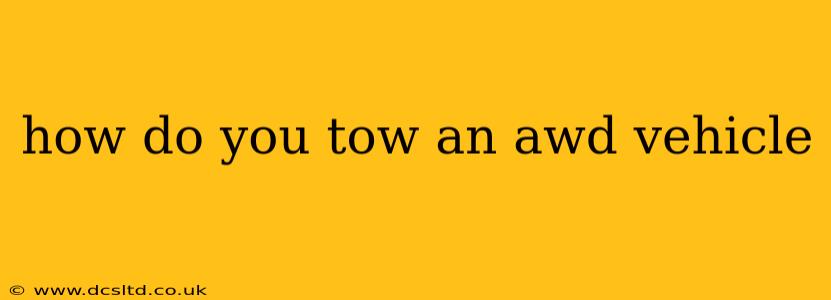How to Tow an AWD Vehicle: A Comprehensive Guide
Towing an all-wheel-drive (AWD) vehicle requires a bit more finesse than towing a front-wheel-drive (FWD) or rear-wheel-drive (RWD) vehicle. Incorrect towing can damage the vehicle's transmission and drivetrain, leading to costly repairs. This guide covers the essential steps and considerations for safely towing your AWD car.
Understanding AWD Drivetrains:
Before we dive into the towing methods, it's crucial to understand how AWD systems work. Unlike RWD or FWD vehicles, AWD vehicles typically distribute power to all four wheels. This means the drivetrain components, including the transfer case, differentials, and axles, are constantly engaged. This engagement is what makes towing AWD vehicles more complex. Towing an AWD vehicle incorrectly can cause significant internal damage.
The Crucial Question: Flatbed vs. Wheel Lift?
The most important decision you'll make is how to tow your AWD car: flatbed or wheel lift.
1. Flatbed Towing: This is the recommended method for towing most AWD vehicles. A flatbed tow truck lifts the entire vehicle, minimizing stress on the drivetrain. The vehicle's wheels remain off the ground during towing, eliminating any rotational force on the drivetrain components. This is the safest and most damage-free way to transport your AWD vehicle.
2. Wheel Lift Towing (Dolly or Tow Bar): Wheel lift towing, using a dolly (lifting the rear wheels) or a tow bar (connecting the front wheels), is generally not recommended for AWD vehicles, especially without consulting your vehicle's owner's manual. Some AWD systems can tolerate wheel lift towing, but others will be severely damaged. Incorrect towing procedures can cause damage to the transmission and transfer case.
H2: What are the risks of towing an AWD vehicle improperly?
Improper towing of an AWD vehicle can lead to several serious problems, including:
- Transmission damage: Forcing the drivetrain to rotate while towed can cause significant internal damage to the transmission, often requiring costly replacement.
- Transfer case damage: The transfer case, responsible for distributing power to the front and rear axles, can be severely damaged by improper towing methods.
- Driveshaft damage: The driveshafts connecting the transmission to the axles can be stressed and damaged.
- Differential damage: Differentials, which allow the wheels on an axle to rotate at different speeds during turns, can also sustain damage from forced rotation during towing.
H2: How do I know if my AWD vehicle can be wheel lift towed?
Consult your owner's manual! This is the most critical step. The manual will specify whether your vehicle can be wheel lift towed and, if so, the correct method (front or rear wheel lift). It will also often indicate the maximum towing speed. Ignoring this information could void your warranty and result in expensive repairs.
H2: What is the correct procedure for flatbed towing an AWD vehicle?
Flatbed towing is simple and safe: the tow truck operator will secure your vehicle using straps or chains, ensuring it's stable and secure on the flatbed. No special procedures are usually required beyond ensuring your vehicle is properly secured.
H2: My AWD vehicle needs to be towed – What should I do?
- Consult your owner's manual: Determine if your vehicle can be wheel lift towed and, if so, the proper procedure.
- Contact a reputable towing service: Clearly inform the towing service that your vehicle is AWD and provide the details from your owner's manual. Choose a company familiar with towing AWD vehicles.
- Verify towing method: Confirm that the tow truck operator understands the specific towing requirements for your vehicle model and will use the appropriate method (flatbed is always recommended unless explicitly stated otherwise in your owner's manual).
H2: Can I tow my AWD vehicle myself?
Unless you are extensively trained and have the right equipment, it is strongly advised against attempting to tow your AWD vehicle yourself. Incorrect procedures can lead to significant damage and potentially unsafe situations. Leave it to the professionals.
Conclusion:
Towing an AWD vehicle safely requires careful consideration and adherence to the manufacturer's recommendations. Always prioritize flatbed towing to avoid potential damage to your drivetrain. Consulting your vehicle's owner's manual is the first and most vital step in ensuring the safe and correct towing of your AWD vehicle. Remember, preventing damage is far cheaper than repairing it.
